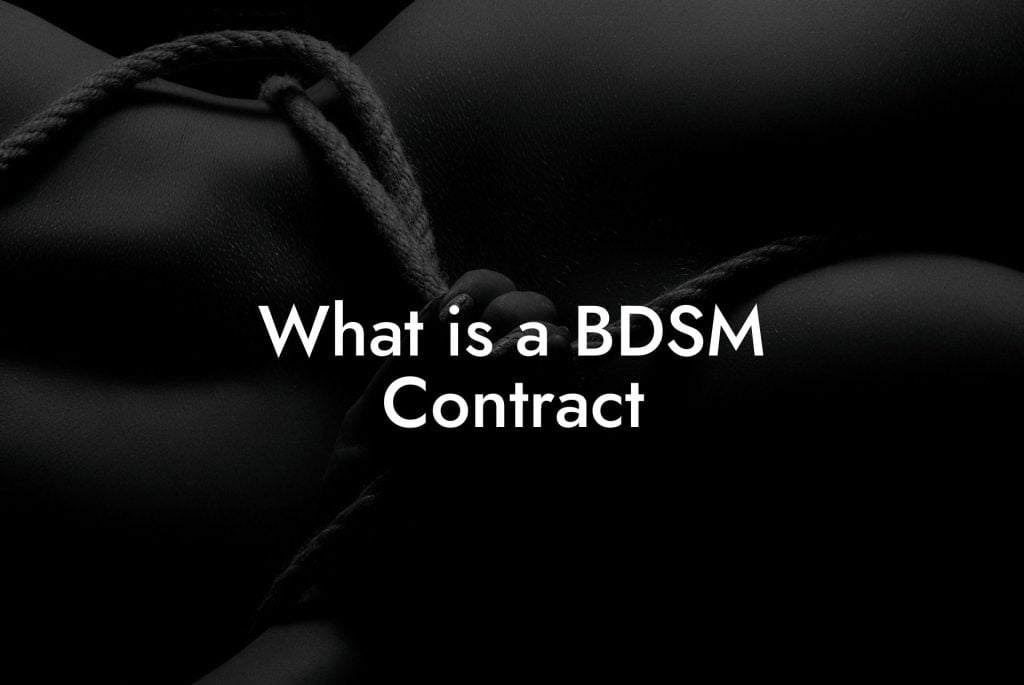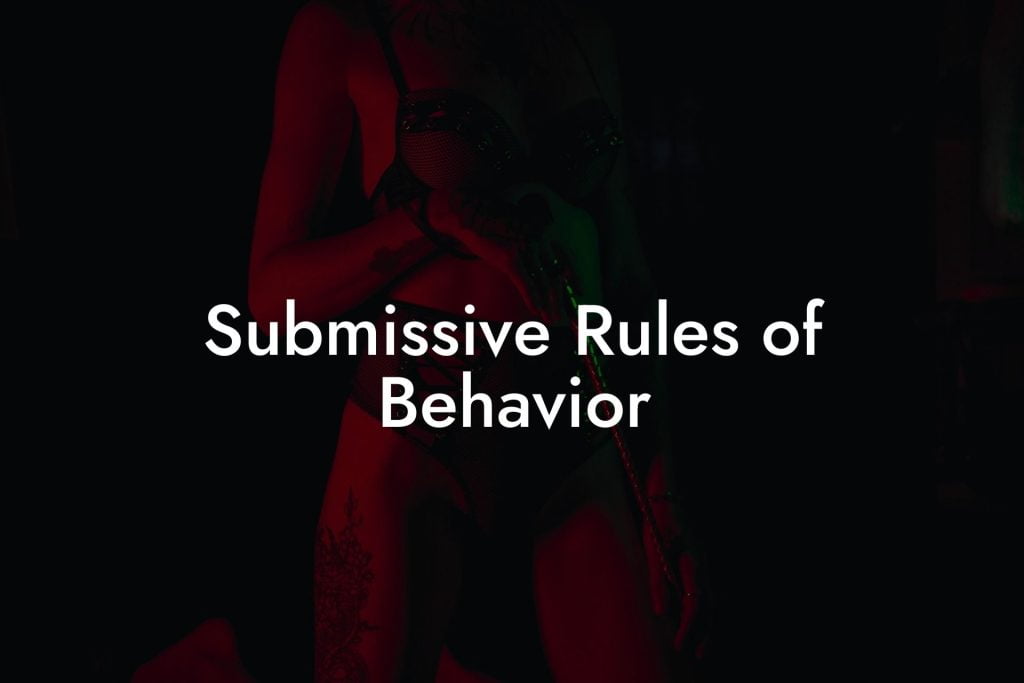Submissive and Dominant Agreement
In the exciting world of BDSM and kink, the submissive and dominant agreement forms the foundation for a healthy and consensual power exchange dynamic. This agreement establishes the rules, boundaries, and expectations between a submissive and a dominant partner, ensuring both parties engage in fulfilling and safe experiences. Whether you are new to BDSM or a seasoned participant, understanding the key elements of this agreement is essential for developing and maintaining a successful D/s relationship.
Creating a submissive and dominant agreement requires open and honest communication, explicit consent, and a thorough understanding of each individual's limits and desires. Let's explore the essential components of this agreement:
1. Communication:
Effective communication lays the groundwork for any BDSM relationship. Both the submissive and dominant must feel comfortable discussing their needs, desires, and fears. Regular and ongoing communication helps build trust, allows for adjustments, and enables the relationship to thrive. It is crucial to establish clear channels of communication, whether through face-to-face conversations, written exchanges, or the use of safewords.
2. Consent:
Consent is the cornerstone of any healthy power exchange relationship. It is vital that all parties involved consent to the activities and dynamics within the submissive and dominant agreement. Consent should be enthusiastic, informed, and revocable at any time. Safe, sane, and consensual play ensures that both partners feel respected and valued.
3. Boundaries:
Understanding personal boundaries is essential for establishing a fulfilling BDSM dynamic. Submissives and dominants should clearly define their hard limits, which are activities they absolutely don't wish to engage in, and soft limits, which are activities they may be willing to explore under certain circumstances. Respecting each other's boundaries is imperative, as it maintains a safe and consensual space for both partners.
4. Power Exchange Dynamics:
The main dynamic within a submissive and dominant agreement centers around power exchange. Discuss and establish what roles each partner will take on, whether it be a Master/Mistress and slave dynamic or any other variation. Define the expectations, responsibilities, and power dynamics involved, ensuring that both partners are enthusiastic and consenting participants.
Submissive and Dominant Agreement Example:
To better grasp how a submissive and dominant agreement works, let's delve into a realistic example. Meet Sarah, a submissive, and James, her dominant partner. They have decided to explore a 24/7 power exchange dynamic. Their agreement includes regular check-ins, weekly scene negotiations, and the use of a safeword. They have both clearly communicated their desires, limits, and expectations to ensure a safe and enjoyable experience for both.
Frequently Asked Questions
What is a BDSM contract?
A BDSM contract is a written agreement between individuals engaging in BDSM activities that outlines the roles, limits, and preferences of each participant. It serves as a communication tool to ensure that all parties have a clear understanding of the expectations and boundaries within their dynamic.
Are BDSM contracts legally binding?
No, BDSM contracts are not legally binding documents. They are more symbolic agreements that reflect the commitment and consent of the parties involved. However, they can be used to demonstrate the consent of all parties in certain legal contexts.
How does a BDSM contract help in establishing consent?
A BDSM contract helps establish consent by documenting the explicit agreement to the activities, roles, and limits that have been discussed between the parties. It ensures that everyone involved has a mutual understanding and agreement of what is to be expected.
What are the common components found in BDSM contracts?
Common components of a BDSM contract often include personal limits, safe words, duration of the contract, expectations, rules, roles, and how disputes or concerns will be addressed. It may also cover aspects of privacy, health, and safety precautions.
Can a BDSM contract be changed?
Yes, a BDSM contract can and should be updated as the relationship evolves or as participants learn more about their desires and limits. It’s important to have regular discussions to ensure the contract remains relevant and consensual for all parties involved.
What is power dynamics in BDSM?
Power dynamics in BDSM refers to the deliberate and consensual exchange of power between participants. Usually, one person assumes more control or power (the dominant), and another person gives up some level of control or power (the submissive).
Is a BDSM contract necessary for engaging in power dynamics?
While not strictly necessary, a BDSM contract can greatly enhance the understanding and safety of engaging in power dynamic relationships. It creates a strong foundation of expectations and consent for all parties.
How can trust be built and maintained in a BDSM relationship?
Trust can be built and maintained in a BDSM relationship through open communication, honesty, respect, and by consistently honoring boundaries and agreements established through contracts or discussions.
What are safe words?
Safe words are predetermined words or signals used during BDSM activities that indicate consent, discomfort, or the need to stop or slow down immediately. They are essential for maintaining consent and safety.
How do safe words contribute to consent and safety?
Safe words contribute to consent and safety by providing a clear, unmistakable signal that the activity needs to change or halt. This allows all participants to manage intensity and maintain well-being throughout the experience.
What role does aftercare play in BDSM?
Aftercare refers to the physical and emotional care given after a BDSM scene to help all participants recover and reconnect. It can involve treating any physical discomfort as well as providing reassurance, comfort, and discussing the experience.
How can disagreements be handled in a BDSM dynamic?
Disagreements in a BDSM dynamic should be handled with open and calm communication, respecting each individual's feelings and perspectives. Negotiation, revisiting the contract, and possibly seeking the advice of a neutral third party can also be beneficial.
What should you do if boundaries are crossed during a BDSM activity?
If boundaries are crossed, all activity should stop immediately using safe words or signals. Then, it's critical to engage in a supportive dialogue to discuss what happened and how to prevent it in the future, and if needed, seek external support or counseling.
How important is privacy in a BDSM relationship?
Privacy in a BDSM relationship is crucial due to the sensitive nature of the activities and the potential stigma from those outside the lifestyle. Trust can be severely damaged if privacy is not respected, so discretion is paramount.
Should negotiations about a BDSM relationship be documented?
Documenting negotiations about a BDSM relationship can be very helpful for clarity and future reference. This can either be in the form of a formal contract or written communication such as emails or texts.
How do you introduce the idea of a contract to a partner?
Introduce the idea of a contract to a partner in a non-confrontational and open way, emphasizing the benefits of clarity and mutual understanding. Present it as a tool for enhancing the relationship rather than imposing rules.
Can anyone engage in a BDSM relationship?
Anyone can engage in a BDSM relationship as long as they are of legal age, consent to the activities, and have the maturity to understand and respect the boundaries and needs of all participants.
What if someone has a change of heart about their BDSM contract?
If someone has a change of heart, it's important to communicate this as soon as possible and renegotiate the terms. A BDSM contract should be flexible to accommodate the evolving nature of a relationship.
How do you establish safety protocols in a BDSM relationship?
Safety protocols in a BDSM relationship are established through transparent communication about risks, safe words or gestures, aftercare needs, and regular health check-ins. Including these in the contract and respecting them at all times is essential.
Can a BDSM contract address emotional boundaries?
Yes, a BDSM contract can and should address emotional boundaries to ensure that the mental and emotional well-being of all parties is considered and safeguarded.
What are some misconceptions about BDSM contracts?
Misconceptions about BDSM contracts include them being seen as overly controlling, exclusively sexual, or legally enforceable. In reality, they are mutual agreements that promote well-being and consent where the legality is symbolic more than enforceable.
Is experience in BDSM necessary before signing a contract?
While experience in BDSM can be beneficial before signing a contract, it is not strictly necessary. What is crucial is understanding your own limits and desires, and being able to communicate them effectively.
In conclusion, a submissive and dominant agreement is a crucial component of any thriving BDSM relationship. Effective communication, explicit consent, and understanding boundaries are the pillars that uphold this agreement. Remember, consent is paramount, and constant ongoing communication helps maintain a healthy D/s dynamic. If you found this guide insightful, be sure to share it with others and explore our website, Filthy Adult, for more comprehensive guides, our Ultimate BDSM Contract Pack, and an enticing selection of fetish products.













